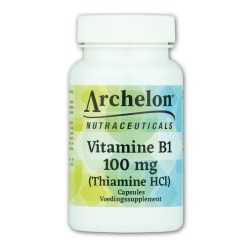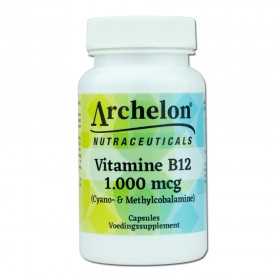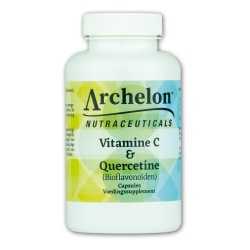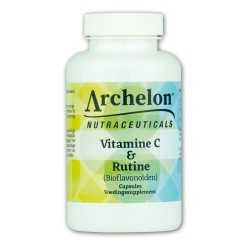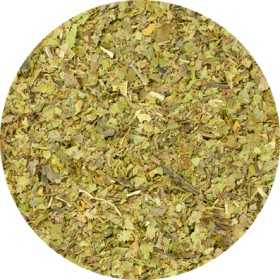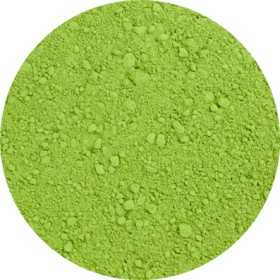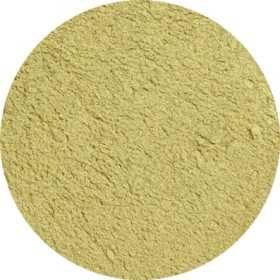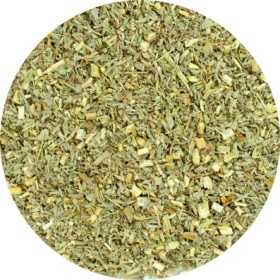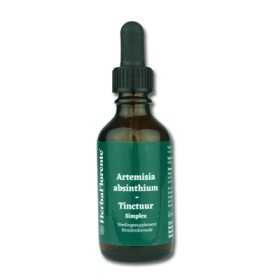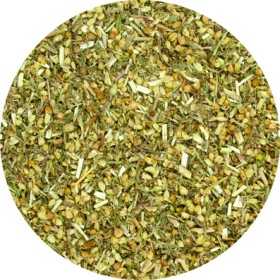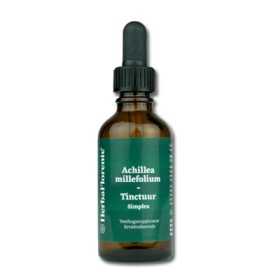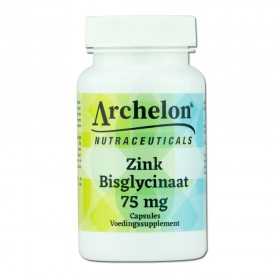Stomach
There are 231 products.
Vitamin B1 (Thiamine HCl) - 100 mg
Vitamin B1 (Thiamine) is the precursor of the biologically active form of vitamin B1, thiamine pyrophosphate (TTP). Magnesium is required for the conversion of thiamine into TTP. Thiamine pyrophosphate is involved as a coenzyme in various reactions related to energy metabolism. Including the release of energy from fats, carbohydrates and proteins. It plays a role in energy metabolism in all cells, including the cells of the heart and nervous system. With which it contributes to the normal functioning of the heart and nervous system. Vitamin B1 is also important for brain and nerve functions, which are decisive for aspects such as concentration, memory and mood.
€19.95
Vitamin B12 (Cyano- & Methylcoblamin) - 1,000 mcg
Vitamin B12 plays a role in homocysteine metabolism. Vitamin B12 is also involved in the cell division process and the production of red blood cells, among other things. It also plays a role in the citric acid cycle, which is important for energy metabolism and can help reduce fatigue. Vitamin B12 is also important for normal functioning of the nervous system, good for concentration, memory and mood.
€19.95
Vitamin C & Quercetin (Bioflavonoids)
The pure form of vitamin C is ascorbic acid. The buffered forms of ascorbic acid are generally better tolerated by humans than the pure form. Ascorbic acid is acidic and the buffered forms give virtually no gastrointestinal problems. Vitamin C is an essential vitamin for the body. It is involved in many processes in the body, including immune system, blood vessels, bones, cartilage, gums, teeth, skin, energy metabolism, nervous system and fatigue.
Quercetin is a flavonoid, also called bioflavonoid. This natural plant compound is found in various plants, fruits and vegetables. Flavonoids are responsible for the vibrant colors (pigments) in these plants and come in various shades. They play a crucial role in plant metabolism, regulate growth, provide protection against UV light, oxidation.
Quercetin is a flavonoid, also called bioflavonoid. This natural plant compound is found in various plants, fruits and vegetables. Flavonoids are responsible for the vibrant colors (pigments) in these plants and come in various shades. They play a crucial role in plant metabolism, regulate growth, provide protection against UV light, oxidation.
€29.95
Vitamin C & Rutin (Bioflavonoids)
The pure form of vitamin C is ascorbic acid. The buffered forms of ascorbic acid are generally better tolerated by humans than the pure form. Ascorbic acid is acidic and the buffered forms give virtually no gastrointestinal problems. Vitamin C is an essential vitamin for the body. It is involved in many processes in the body, including immune system, blood vessels, bones, cartilage, gums, teeth, skin, energy metabolism, nervous system and fatigue.
Rutin, also known as a flavonoid or bioflavonoid, is a naturally occurring substance in vegetables, fruits, herbs and plants. It is known for its vibrant pigmentation and can have different colors. Rutin plays several important roles in plants, such as regulating growth, protecting against UV radiation, oxidation and heat,
Rutin, also known as a flavonoid or bioflavonoid, is a naturally occurring substance in vegetables, fruits, herbs and plants. It is known for its vibrant pigmentation and can have different colors. Rutin plays several important roles in plants, such as regulating growth, protecting against UV radiation, oxidation and heat,
€29.95
Vitamin C (Sodium Ascorbic Acid) - 625 mg
The pure form of vitamin C is ascorbic acid. The buffered forms of ascorbic acid are generally better tolerated by humans than the pure form. Ascorbic acid is acidic, the fused forms give virtually no gastrointestinal problems. Vitamin C is an essential vitamin for the body. It is involved in many processes in the body, including immune system, blood vessels, bones, cartilage, gums, teeth, skin, energy metabolism, nervous system and fatigue.
€17.95
Vitamine A (acétate de rétinol) - 4,000 UI - 1,200 mcg
Vitamin A is involved in various biochemical and physiological processes in the cell. For example, vitamin A binds to so-called retoinden receptors that ensure the activation or inactivation of genes that play a role in the cell specialization process. Cells acquire their specific functionality, depending on the type of tissue they are part of. Sufficient intake of vitamin A is also important for vision, but not only for the ability to adapt vision to a dark environment. Vitamin A also maintains a good structure and moisture balance of the cornea through tears. Furthermore, this vitamin is necessary for the integrity of epithelial cells in the body and thus supports the quality of the skin and mucous membranes (including in the intestine and lungs).
€15.95
Vlezige Hokjespeul (Astragalus) - Astragalus chinensis membranus
Astragalus, also known as Fleshy Locust (Astragalus membranaceus), is a plant native to Asia. It has been used for 2000 years in traditional Chinese herbal medicine to strengthen the immune system. In addition to this property, astragalus has many other benefits. According to Chinese tradition, it strengthens the life force, or 'qi', as it is called in China, when ingested. It is known as a powerful antioxidant and is especially valued for its ability to support the immune system.
€2.90
From: €2.90
Walnut - Juglans regia
The Juglans regia, also known as walnut, walnut or walnut, belongs to the walnut family (Juglandaceae). This species is also known as common walnut or Persian walnut, to avoid confusion with the genus Juglans. Other species in the genus Juglans include the white walnut and the black walnut.
This deciduous tree can reach a height of up to 30 meters with a crown that can be more than 10 meters wide. The leaves are odd-pinnate and can be 25-40 cm long, consisting of five to nine leaflets per compound leaf. The three largest leaflets are located at the end of the leaf and measure 10-18 cm long and 6-8 cm wide. The leaflets at the base of the leaf are smaller, usually 5-8 cm long.
This deciduous tree can reach a height of up to 30 meters with a crown that can be more than 10 meters wide. The leaves are odd-pinnate and can be 25-40 cm long, consisting of five to nine leaflets per compound leaf. The three largest leaflets are located at the end of the leaf and measure 10-18 cm long and 6-8 cm wide. The leaflets at the base of the leaf are smaller, usually 5-8 cm long.
€2.00
From: €2.00
Wheatgrass - Triticum aestivum
Wheatgrass is a nutritious source of vitamins A, C and E, calcium, magnesium and iron. It also contains high concentrations of chlorophyll and natural enzymes. The crop even consists of 70% chlorophyll.
€2.00
From: €2.00
Wormwood Herb - Artemisia absinthium
Absinthe wormwood (Artemisia absinthium) is a plant from the composite family (Asteraceae). This species is on the Dutch Red List of plants as quite rare and moderately reduced in numbers. It is a perennial plant that grows naturally on dry, calcareous, nitrogen-rich and cultivated soils in temperate regions of Europe, Asia and North Africa. The genus name Artemisia is derived from the Greek hunting goddess Artemis.
The buds of wormwood absinthe are traditionally seen as medicinal. The bitter extract of these buds is an important ingredient in drinks such as vermouth and classic absinthe. The most important flavorings are absinthine and the menthol-smelling terpene thujone.
The buds of wormwood absinthe are traditionally seen as medicinal. The bitter extract of these buds is an important ingredient in drinks such as vermouth and classic absinthe. The most important flavorings are absinthine and the menthol-smelling terpene thujone.
€2.00
From: €2.00
Wormwood Herb - Artemisia absinthium - Cut
Absinthe wormwood (Artemisia absinthium) is a plant from the composite family (Asteraceae). This species is on the Dutch Red List of plants as quite rare and moderately reduced in numbers. It is a perennial plant that grows naturally on dry, calcareous, nitrogen-rich and cultivated soils in temperate regions of Europe, Asia and North Africa. The genus name Artemisia is derived from the Greek hunting goddess Artemis.
The buds of wormwood absinthe are traditionally seen as medicinal. The bitter extract of these buds is an important ingredient in drinks such as vermouth and classic absinthe. The most important flavorings are absinthine and the menthol-smelling terpene thujone.
The buds of wormwood absinthe are traditionally seen as medicinal. The bitter extract of these buds is an important ingredient in drinks such as vermouth and classic absinthe. The most important flavorings are absinthine and the menthol-smelling terpene thujone.
€2.00
From: €2.00
Wormwood Tincture - Artemisia absinthium Tincture
Single herbal tincture made with dried herb of Artemisia absinthium (Wormwood).
Wormwood (Artemisia absinthium) is a plant in the Asteraceae family. This species is listed on the Dutch Red List of Plants as relatively rare and moderately declining. It is a perennial plant that grows naturally in dry, calcareous, nitrogen-rich, and cultivated soils in temperate regions of Europe, Asia, and North Africa. The genus name Artemisia is derived from the Greek goddess of hunting, Artemis.
Wormwood (Artemisia absinthium) is a plant in the Asteraceae family. This species is listed on the Dutch Red List of Plants as relatively rare and moderately declining. It is a perennial plant that grows naturally in dry, calcareous, nitrogen-rich, and cultivated soils in temperate regions of Europe, Asia, and North Africa. The genus name Artemisia is derived from the Greek goddess of hunting, Artemis.
€10.95
Yarrow - Achillea millefolii
Yarrow (Achillea millefolium) is an herb that belongs to the daisy family (Asteraceae). It is a winter-hardy, perennial plant that is common in the Netherlands. It has finely divided, feathery leaves and small white flowers that tend toward pink. The use of this herb has been around for centuries. Yarrow is used, among other things, to support digestion and promote fat metabolism. The herb is beneficial for the blood vessels, urinary tract and respiratory tract. It helps with normal menstruation.
€2.00
From: €2.00
Yarrow Tincture - Achillea millefolium Tincture
Single herbal tincture made with dried herb of Achillea millefolium (Yarrow).
Yarrow (Achillea millefolium) is an herb that belongs to the daisy family (Asteraceae). It is a winter-hardy, perennial plant that is common in the Netherlands. It has finely divided, feathery leaves and small white flowers that tend toward pink. The use of this herb has been around for centuries. Yarrow is used, among other things, to support digestion and promote fat metabolism. The herb is beneficial for the blood vessels, urinary tract and respiratory tract. It helps with normal menstruation.
Yarrow (Achillea millefolium) is an herb that belongs to the daisy family (Asteraceae). It is a winter-hardy, perennial plant that is common in the Netherlands. It has finely divided, feathery leaves and small white flowers that tend toward pink. The use of this herb has been around for centuries. Yarrow is used, among other things, to support digestion and promote fat metabolism. The herb is beneficial for the blood vessels, urinary tract and respiratory tract. It helps with normal menstruation.
€11.95
Zinc Bisglycinate - 75 mg
Zinc is available in different forms. Zinc bisglycinate has a very good bioavailability. It is a chelated form of zinc bound to two (bis) molecules of the amino acid glycine which has more benefits for the body. Zinc has a very wide range of action and is involved in many body processes. Zinc is essential for the activity of more than 300 enzymes that have the zinc ion as a cofactor. Zinc is also important for proteins and cell membranes. Zinc is important for the immune system, acid-base metabolism, carbohydrate metabolism, DNA synthesis, cognitive functions, fertility, reproduction, vitamin A metabolism, macronutrient metabolism, bones, hair, skin, nails, hormones and cell division, among other things.
€16.95















